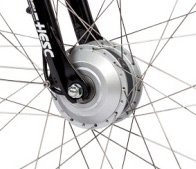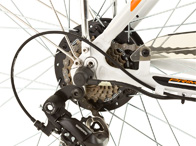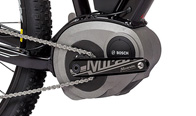Devron - European Bike Manufacturer
Brand Development In 1999, a Romanian company named DHS Bike Parts was founded. It later created the DHS brand which started to produce all types of bicycles....
16. 3. 2017
Compared products
These days, e-bikes are no longer considered a transport for the infirm and the elderly. They are bikes suited for both men and women to comfortably commute to work, journey through the mountains or undergo cardio exercises effectively. Therefore, it is important to choose a bike that will suit all your needs. This guide will help you to find the correct e-bike for you and tell you what is important to look for while choosing.
First, let’s talk about how exactly electric bike functions. Electric bike is a classic bicycle that uses an electric motor to help you pedal. The electric drive supplies additional power to ease your effort while pedalling. This allows you to ride a classic bicycle more comfortably and without much effort. The difference is most notable when riding uphill. You can adjust the power intensity through a controller on your handlebars. The standard range of power intensity is 3 – 5 levels. Naturally, it is possible to completely disengage the motor and ride the bike regularly, but let’s face it, you’ll break a bit of sweat doing that.
City e-bike - A bicycle suitable for seniors and travelling through a city
City e-bikes are distinguished mainly by their monotube step-through frame, that makes getting on/off easier and helps you navigate urban traffic more safely. Seniors especially will appreciate the boost while pedalling and an easy way to get on. City e-bikes are also suitable for those who frequently commute and like to be comfortable while riding. A city e-bike’s accessories, such as mudguards, lights or carriers also play an important role, as they widen the e-bike’s range of use, making it suitable for your daily commute to work or school or for shopping trips, without arriving at your destination breathless and sweaty. Urban travel has never been easier.
Trekking e-bike - A bicycle suitable for longer trips on roads or slight terrain
Trekking e-bikes are a compromise between mountain and city e-bikes, suitable mainly for longer trips on roads or in slight terrain. Trekking e-bikes are often used on family trips, where the electric motor helps the less proficient members to keep up with the others. Trekking bikes have a wide range of available accessories as well, for example lights, mudguards or carriers.
These days, trekking e-bikes are being used mainly for cardio training. You can adjust the intensity of the power boost in order to achieve optimum heart rate frequency for burning fats. What it means is, that while riding uphill, you’ll set a more intense power boost than on an even surface to keep your heart rate frequency even. As a result, burning fats with an e-bike is easier and more effective than on a regular bike.
Mountain e-bike - A bicycle suitable for rocky terrain
Mountain e-bikes are distinguished mainly by a durable frame and a high-output motor that will help you pedal even in the most difficult terrain. At the same time, it is important to keep the mountain e-bike properly balanced. That’s why the battery is usually placed directly under the frame tube. This adds to the aerodynamic and attractive design. Mountain e-bikes have gone through significant changes lately, so now even less experienced cyclists can use them to overcome difficult mountain paths.
Battery is the most important part of an e-bike, but also one of its most changeable aspects. Its type and capacity determines the e-bike’s distance range, charging life or service life. Its individual parameters are one of the most important, so let’s look at them closer.
Battery range and capacity
The main attribute is the battery’s capacity, which determines the e-bike’s range. However, riding style, type of terrain, the cyclist’s weight and the boost intensity level are also important factors. That’s why the given range won’t be always the same and may slightly vary in reality. Nevertheless, we test all our e-bikes and try to present the most relevant values.
For illustration purposes, we may categorize the battery range according to its capacity, as follows:
Battery service life
These days, e-bikes are usually powered by modern-type lithium batteries, Li-Pol, Phylion or Li-Ion, which are the most commercially used types of batteries. They are most notable for their good weight/capacity and longevity/price ratios. The standard power supply is 36 V. The service life of a battery is determined by the frequency of its use, its maintenance, etc. Generally, it can be said that the battery’s service life ranges somewhere between 20 000 – 30 000 km travelled, 4 – 8 years of use or 800 – 1000 charging cycles.
Other facts about e-bike batteries
How to Care for the Battery
For the battery to last as long as possible, it is necessary to properly care for it. It is important for lithium batteries to be regularly charged to maximum capacity, ideally after every ride. It is not recommended to make a habit of completely depleting the battery or interrupting the charging process. Lithium batteries don’t do well under high temperatures, that’s why we recommend not exposing them to temperatures over 35°C. Freezing temperatures (under 0°C) are not suitable either. These factors, as well as the intensity of its use, influence the length of the battery’s service life. That’s why its actual longevity may not correspond with the warranty-covered period.
Battery placement
The battery placement partially determines the riding qualities of the bike and the way it is controlled. It is not an overly important parameter, but we’ll still provide a brief explanation.
Carrier battery – this battery is used with city or trekking e-bikes, because carriers are usually used with these types of bikes. The carrier has two levels, which allows you to affix a basket or a bag to the top. Also, the battery is easily accessible, which will be appreciated especially when you'll need to charge it.
Frame battery – this type of battery is placed on the bike frame instead of a water bottle carrier. It is logically the best place to put it and keep the bike balanced, that’s why this type of battery placement is most often seen on mountain bikes. This way, a nice and aerodynamic design is maintained.
Seat post battery – this type of battery may be considered proportionately placed as well, but at the expense of a longer frame. Because of this the chain/pedalling system must be longer as well, which often leads to the e-bike having only one derailleur. This type is therefore most often used with folding e-bikes.
The motor is the e-bike’s main power supply and one of the most important attributes influencing the bike’s performance. We recognize several basic types of motors, differing in output, voltage and placement. Every motor has certain advantages, and therefore there isn’t one that is universally considered the best. Let’s look at the individual types.
Front hub electric motor
Advantages: low price, even weight distribution, suitable for urban areas
Disadvantages: suitable only for riding on roads
 The front hub motor is used mainly with city e-bikes, that are assumed to be used only on tarmac roads. The advantage of placing the battery at the front is an even distribution of weight, where the motor balances out the weight of the accumulator that is most often located at the rear (on the carrier). Another advantage is easy motor installation, that’s why the price of this type of motor is lower. But the front wheel motor also comes with disadvantages. The most notable is the risk of the front wheel skidding on wet or uneven surfaces. That’s why front hub motors are recommended for urban traffic, where the risk of the wheel skidding is not as high. The weight and pressure put on the fork is also not ideal and makes it more difficult to bounce the wheel when riding on curbs or uneven terrain. However, if you plan on riding mainly in urban areas and don’t want to spend too much money, front hub motor is ideal for you. Assist levels are usually graded by the speed limit, which turn off when reaching certain speed. (first level, for example at 12 km/h, second at 15 km/h, and so on, the highest level at 25 km/h)
The front hub motor is used mainly with city e-bikes, that are assumed to be used only on tarmac roads. The advantage of placing the battery at the front is an even distribution of weight, where the motor balances out the weight of the accumulator that is most often located at the rear (on the carrier). Another advantage is easy motor installation, that’s why the price of this type of motor is lower. But the front wheel motor also comes with disadvantages. The most notable is the risk of the front wheel skidding on wet or uneven surfaces. That’s why front hub motors are recommended for urban traffic, where the risk of the wheel skidding is not as high. The weight and pressure put on the fork is also not ideal and makes it more difficult to bounce the wheel when riding on curbs or uneven terrain. However, if you plan on riding mainly in urban areas and don’t want to spend too much money, front hub motor is ideal for you. Assist levels are usually graded by the speed limit, which turn off when reaching certain speed. (first level, for example at 12 km/h, second at 15 km/h, and so on, the highest level at 25 km/h)
Rear hub electric motor
Advantages: good torque transfer, suitable for slight terrain
Disadvantages: higher weight at the rear of the bike (unbalanced)
 It could be said that the attributes of the rear hub electric motor are the direct opposite of the front hub motor’s attributes, as described above. The main advantage is a better transfer of torque, preventing skidding even in terrain. Operations with the front wheel are easier as well, allowing you to ride over curbs and other obstacles without a problem. The disadvantage is that the motor makes the bike unbalanced, which leads to higher pressure being put on the components at the rear, causing them to wear more quickly. Since this is the only disadvantage, rear wheel motors are the most common. If you plan on riding on roads, as well as slight terrain, the rear hubl motor is an ideal choice for you. This type of motor is most often used with mountain and trekking e-bikes. Assist levels are usually graded by the speed limit, which turn off when reaching certain speed. (first level, for example at 12 km/h, second at 15 km/h, and so on, the highest level at 25 km/h)
It could be said that the attributes of the rear hub electric motor are the direct opposite of the front hub motor’s attributes, as described above. The main advantage is a better transfer of torque, preventing skidding even in terrain. Operations with the front wheel are easier as well, allowing you to ride over curbs and other obstacles without a problem. The disadvantage is that the motor makes the bike unbalanced, which leads to higher pressure being put on the components at the rear, causing them to wear more quickly. Since this is the only disadvantage, rear wheel motors are the most common. If you plan on riding on roads, as well as slight terrain, the rear hubl motor is an ideal choice for you. This type of motor is most often used with mountain and trekking e-bikes. Assist levels are usually graded by the speed limit, which turn off when reaching certain speed. (first level, for example at 12 km/h, second at 15 km/h, and so on, the highest level at 25 km/h)
Mid-Drive
Advantages: ideal balance, more intuitive assistance, motor's high effectivity, suitable into difficult terrain and steep hills
Disadvantages: higher price
 Where balance and riding attributes are concerned, the centre of the bike is the most ideal place to put the motor in. Such position ensures high performance and fast reactions of the pedalling boost. The motor’s revolutions per minute are also set to optimum, which saves energy and can widen the battery’s range by as much as 20%.In contrast to the above-mentioned types of motors, the center drive assists you with the lowest level of assistance at any speed up to 25 km/h. However, the disadvantage of these motors is their high price. That’s why they can be found mostly on higher class e-bikes. This type of electric motor is suitable especially for mountain e-bikes that help you ride through the most difficult terrain, but other types of e-bikes might be equipped with it as well. Mid-drive is considered to be the most sophisticated type of e-bike motor.
Where balance and riding attributes are concerned, the centre of the bike is the most ideal place to put the motor in. Such position ensures high performance and fast reactions of the pedalling boost. The motor’s revolutions per minute are also set to optimum, which saves energy and can widen the battery’s range by as much as 20%.In contrast to the above-mentioned types of motors, the center drive assists you with the lowest level of assistance at any speed up to 25 km/h. However, the disadvantage of these motors is their high price. That’s why they can be found mostly on higher class e-bikes. This type of electric motor is suitable especially for mountain e-bikes that help you ride through the most difficult terrain, but other types of e-bikes might be equipped with it as well. Mid-drive is considered to be the most sophisticated type of e-bike motor.

Motor output
Regardless of the motor’s placement, the motors are also distinguished by their output. Usually, 250W motors are used. Because this is the legally given maximum for road use, more powerful motors are rare. However, if an e-bike has a motor more powerful than 250W (i.e. 350W), the controller will limit its output to 250W so that it meets regulations. So, what is the advantage of more powerful motors? If the motor output is intentionally limited, it allows for a steady power reserve that will alleviate its load and prolong its service life. Sports e-bikes allow you to unlock the output limitation and use the motor’s full power while not on a road.
Cycling program:
The program settings are different for every e-bike, but there are usually 3-5 programs. The number of programs is not as important as the type of the motor, as described above. Nevertheless, generally we can say that the more programs there are, the smoother the pedalling boost adjustment is. The programs determine how much of a boost you will receive while pedalling – the motor will engage the moment you push into the pedals.
Correct frame size:
An ideal frame size is the same you would use for a regular bike – derived from your height. Individual users can, however, have different body types (longer arms/legs), so it is best to try the e-bike out. If that is not an option for you, you can pick out a bike based on your height with 90% accuracy. The frame size is also determined by the type of the e-bike. It is recommended for cross and trekking bikes to have frames 1 or 2 inches bigger. You can find a detailed size table via this link.
Weight limit:
Most e-bikes have a relatively high weight limit in the range of 110 – 150 kg. Devron e-bikes are tested to meet the CE standard for a 120-kg weight limit. However, independent testing showed that while using the e-bike in accordance with the user instructions, it can carry up to 150 kg of weight. That’s why e-bikes are suitable for overweight people as well.
E-bike weight:
At first glance, e-bikes look much heavier than regular bikes. But do not be deceived. A big part of the e-bike’s weight is taken up by the battery itself, which weighs around 4-5 kg. You also need to take into account a few grams that will be added by the motor. If you subtract the weight of the motor and the battery, you’ll get the weight of an average bicycle. The weight of an electric bike is usually somewhere between 22 – 26 kg.